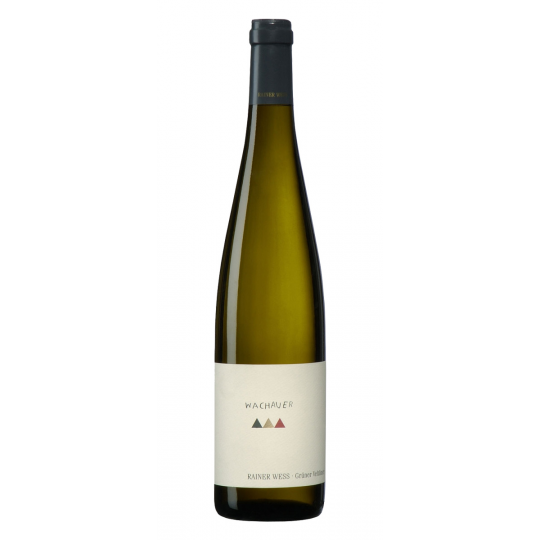Waarom SlimmerWijnKopen wijn?
De beste Wachauer Grüner Veltliner die je hier kunt krijgen, zelfs beter dan op de piste! Origineel aperitief en bij diverse (voor-) gerechten en kazen.
De smaak
Rainer Wess staat voor loepzuivere droge Grüner Veltliners. Helder en licht groen-geel van kleur. Spannend met fijne weidenkruiden, geel appelfruit, een hint van mango, tabak-achtige fijne minerale tonen en een pepertje. Sprankelend en elegant met een mooie zuurgraad en een licht zoetige, fruitige afdronk. Al goed drinkbaar!
De details
type wijn: medium bodied, droge witte wijn
druivensoort: 100% Grüner Veltliner
teelt: conventioneel
alcoholgehalte: 12,50 % vol.
afsluiting: schroefdop drinktemperatuur: 8 - 10 graden
bewaarpotentieel: 2014 - 2016
spijs-aanbeveling:
- kaas: mozzarella, harde geiten, pecorino
- vis: ijgergarnalen, zalm, tonijn, zoute haring
- vlees: gekookte ham (asperges), kipfilet
- salades & antipastas
De oorsprong
In het jaar 2010 moest rijzende ster Rainer Wess zijn bescheidenheid prijsgeven. De internationale wijnpers ontdekte zijn wijnen en gaf direct de hoogste scores. Twee jaar later volgde de bekroning van 800 internationale journalisten, top sommeliers en handelaren tot de nummer 2 nieuwe wijnproducent van Oostenrijk. Dit gebeurde op de grootste en prestigieuze wijnbeurs van Oostenrijk: Vievinum in Wenen.
Rainer Wess krijgt nu wereldwijd veel lof voor zijn wijnen uit de Wachau en het Kremstal. Met een duidelijke eigen stijl van verfijning, terroir, karakter en helder fruit. En dat geldt niet alleen voor zijn cru’s maar ook voor zijn Wachauer Grüner Veltliner en Riesling. Verrassend goed en prijstechnisch uiterst aantrekkelijk.
Langzaam maar gestaag heeft Rainer gewerkt aan de vervulling van zijn droom. Hij deed veel ervaring op bij o.a. Château l’Angelus, Château Cheval Blanc en Robert Mondavi Winery. In Wachau was hij directeur/oenoloog van de Freie Weingärtner Wachau, nu bekend als Domäne Wachau.
Slimme Weetjes: Historie van Grüner Veltliner
Grüner Veltliner has been believed to date back to Roman times with its name is derived from Veltlin (Valtellina) in northern Italy though ampelographers and wine historians have yet to find a link between the grape and the Italian commune. The grape is likely indigenous to Austria. The current name appeared in a document for the first time in 1855 - before that time it was known as Weißgipfler. Only by the 1930s was Grüner Veltliner established as the standard name of the grape. Until the Second World War it was regarded as just another Austrian grape, it took Lenz Moser's Hochkultur system of vine training to really get the best out of it, and it expanded quickly in plantation from the 1950s to later become Austria's most planted variety.
In recent years, Grüner Veltliner has seen an uptick in interest following the results of a 2002 wine tasting organized by Masters of Wine Jancis Robinson and Tim Atkin. Here Grüner Veltliner from Austria beat out several highly acclaimed white Grand cruwines from Burgundy.From Wikipedia, the free encyclopedia.
Slimme Weetjes: Meer over Wachau
The origin of the wine growing tradition in Austria, and in particular in the Wachau valley, and its popularity beyond its borders, is attributed to medieval period of the Roman settlements. The Vinea Wachau Nobilis Districts date to Leuthold I von Kuenring (1243–1313). Wine production peaked under the Carolingians. Krems has a long history as the hub of the Wachau wine trade, while the town of Dürnstein is also known for being one of the Wachau wine centres. Founded in 1983, the Vinea Wachau is an association of vintners who created categories for Wachau wine classification. The vintners of the Vinea Wachau claim to produce quality wine under a manifesto of six Vinea Wachau wine making laws, also known as six Wachau commandments. Their products, known for their purity, are labelled under the categories of Steinfeder, Federspiel or Smaragd.
The Wachau valley is well known for its production of apricots and grapes, both of which are used to produce specialty liquors and wines. The wine district's rolling vineyards produce complex white wines. Wachau is a source of Austria's most prized dry Rieslings and Grüner Veltliners, some of the best from the steep stony slopes next to the Danube on which the vines are planted. The temperature variation in the valley between day and cold nights has a significant role to play in the process of ripening of the grapes. The heat retained in the water and the stoney slopes with thin soil cover facilitates this process of growing fine variety of grapes, which results in the sophisticated wines produced in the valley. Since rainfall is not adequate for the growth of wines on thin soils, irrigation is an essential requirement to give water supply to the wine yards.From Wikipedia, the free encyclopedia.


